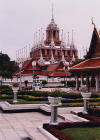|
Lohaprasat (โลหะปราสาท)
Thai-Sanskrit-Khmer. Structure with a spire in metal. There were initially only three Lohaprasat buildings in the world. The original one was built in India in honour of the
Buddha, and had a spire of gold,
which gave it its name, as
loha
is a word derived from
Sanskrit which means ‘metal’, whereas
prasat
is a Khmer word for an
‘ornamental structure with a needle-like spire’. The first Lohaprasat had only two
storeys but around a thousand rooms to house monks. The second was built in Sri Lanka in 161 BC, to commemorate the victory over the Tamil, and had nine
storeys and a brass spire. Built in wood, it was destroyed by lightning and rebuilt as a five storied structure however it no longer exists today. The third Lohaprasat was commissioned by
Rama III, to commemorate his granddaughter princess
Sohmanat
Watana Wadih, who later became the first queen of
Rama IV. The Thai version has
seven storeys with
thirty-seven spires
surrounding
the outside,
one on the top, twenty-four on the second floor, and twelve on the fourth, and
which represent the seven sets of thirty-seven qualities that must be observed in order
to attain
Enlightenment as described in the
Bodhi Pakkhiyah Dhamma (โพธิปักขิยธรรม) discourse given by the Buddha. The Thai Lohaprasat of
Wat Ratchanaddah
is the only one of its kind still intact today. On the
inside it has labyrinth-like hallways (fig.) and a staircase that leads to the top,
where
is a
busabok
that houses a relic of the
Buddha
(fig.)
and offers a bird's-eye view of
Rattanakosin (fig.)
and the temple's adjacent
wihaan (fig.).
The
maze of corridors on the inside has many corners and
niches,
several of which have pedestals with
Buddha images
in different poses. Though
commissioned in the reign of King Rama III, the Loha Prasat remained unfinished until the reign of King
Rama IX, with final construction taking place in several phases, from 1963 to 1977, with the enshrinement of the relic being completed on 27 February 1995 in a ceremony presided over by King
Bhumipon Adunyadet, to mark the start of the Golden Jubilee
of the King's Accession to the Throne, in 1996. In 2003, the building was renovated (fig.) on the
occasions of the APEC-meeting held in
Bangkok, in which many heads of state visited
the capital
and in 2016, its peaks were eventually gilded, thus completing construction up to the state in which it currently remains (fig.).
See MAP,
TRAVEL PICTURES (1)
and
(2),
POSTAGE STAMPS (1)
and
(2), as well as
QUADCOPTER PICTURES (1)
and
(2).
回






|

